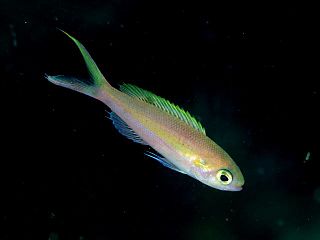Victor Gruschka Springer was an American biologist who was a Senior Scientist emeritus, Division of Fishes at the Smithsonian Institution's National Museum of Natural History in Washington, D.C. He was a specialist in the anatomy, classification, and distribution of fishes, with a special interest in tropical marine shorefishes. He published numerous scientific studies on these subjects; also, a popular book called "Sharks in Question, the Smithsonian Answer Book" 1989.
Gyrinomimus grahami is a flabby whalefish of the genus Gyrinomimus, found in all the southern oceans.
George Sprague Myers was an American ichthyologist who spent most of his career at Stanford University. He served as the editor of Stanford Ichthyological Bulletin as well as president of the American Society of Ichthyologists and Herpetologists. Myers was also head of the Division of Fishes at the United States National Museum, and held a position as an ichthyologist for the United States Fish and Wildlife Service. He was also an advisor in fisheries and ichthyology to the Brazilian Government.

Chrysiptera talboti, known commonly as Talbot's damselfish and Talbot's demoiselle, is a species of damselfish. It is a marine fish from the eastern Indian Ocean and western Pacific.

Symphysanodon, also known as the slopefishes, is a genus of small marine ray-finned fishes. Most are found in the Indo-Pacific, but three species, S. berryi, S. mona, and S. octoactinus, are found in the Western Atlantic. They are found on rocky reefs at depths of 50–700 m (160–2,300 ft). Traditionally, this genus is the only member of the family Symphysanodontidae, but in 2017 a new species, C. aureolateralis, was placed in its own genus Cymatognathus.
Enneapterygius clarkae, the barred triplefin, is a species of threefin blenny in the genus Enneapterygius. It was described by Wouter Holleman in 1982, and was given its species epithet in honour of American ichthyologist Eugenie Clark (1922-2015) It is a tropical blenny known from the Indian Ocean, and has been described from the Red Sea to Natal, South Africa. Male barred triplefins can reach a maximum length of 2.5 centimetres.
Peter Robert Last is an Australian ichthyologist, curator of the Australian National Fish Collection and a senior principal research scientist at CSIRO Marine and Atmospheric Research (CMAR) in Hobart, Tasmania. He is an elasmobranch expert and has described many new species of shark.
Acropoma hanedai is a species of ray-finned fish, a lanternbelly from the family Acropomatidae. It occurs in the north-western Pacific Ocean from southern Japan to Taiwan. It is a food fish which is caught by trawling.
Acropoma lecorneti is a species of ray-finned fish, a lanternbelly from the family Acropomatidae. It is found in the western Pacific Ocean where it has been recorded off Japan and New Caledonia. This species was first formally described by the French ichthyologist Pierre Fourmanoir (1924-2007) with the type locality given as north of the St Vincent Pass off the western coast of New Caledonia at a depth of 360 metres (1,180 ft). The specific name honours the skipper of the fishing boat Thalassa, Monsieur Lecornet, who took the type aboard that vessel.
Phillip Clarence Heemstra was an American-South African ichthyologist. He was born in Melrose Park, Illinois, United States as the son of Clarence William Heemstra and his wife, Lydia. He attended school in Ottawa, Illinois, and completed a B.Sc. Zoology in 1963 at the University of Illinois at Urbana, Illinois, as well as his MSc degree (1968) and doctorate (1974) in marine biology at the University of Miami in Miami, Florida. He moved to live in South Africa in 1978.
Nikolai Vasilyevich Parin was a Soviet and Russian ichthyologist, specializing in oceanic pelagic fish. He headed the Laboratory of Oceanic Ichthyofauna at the RAS Institute of Oceanology in Moscow, where he ended his career as a Professor after more than fifty-seven years. In his career, he described more than 150 new taxa of fish and participated in 20 major oceanic expeditions. Thirty-six species of fish are named in his honour.
Lloyd's slickhead is a species of fish in the family Alepocephalidae (slickheads). The fish is found in the Indo-West Pacific: on Indian Ocean ridges, in the Arabian Sea and the South China Sea. This species reaches a length of 50 cm (20 in).
Creedia alleni is a species of sandburrowers found in the Eastern Indian Ocean in Australia. This species reaches a length of 4 cm (1.6 in).
Creedia bilineata is a species of sandburrowers found in the Northwest Pacific Ocean around Japan. This species reaches a length of 3.2 cm (1.3 in).
Creedia haswelli, the slender sandburrower, is a species of marine ray-finned fish belonging to the family Creediidae, the sandburrowers. This species is found in Southern Australia. This species reaches a length of 7.5 cm (3.0 in).
Branchiostegus paxtoni, or Paxton's tilefish, is a species of marine ray-finned fish, a tilefish belonging to the family Malacanthidae. It is found in the Eastern Indian Ocean and is known only from a locality 190 km northwest of Port Hedland, Western Australia. This species reaches a length of 25.5 cm (10.0 in).

Davidijordania is a genus of marine ray-finned fishes belonging to the family Zoarcidae, the eelpouts. The fishes in this genus are found in the northwestern Pacific Ocean.
Acropoma heemstrai is a species of ray-finned fish in the genus Acropoma. A small sample was found in South Africa and Mozambique.
Acropoma splendens is a species of bioluminescent lanternbelly native to the eastern Indian Ocean. It was described from pair of specimens found in the Arafura Sea.
Epigonus elongatus is a species of deepwater cardinalfish found in the Western Indian Ocean mainly north of Madagascar and quite near the Seychelles. This fish occurs at depths of 300 m (980 ft).


